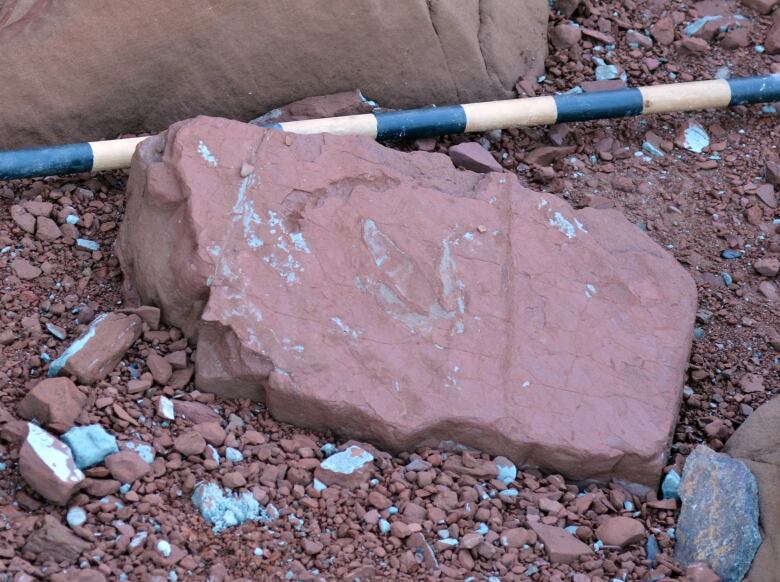200-million-year-old dinosaur footprint fossil found in Nova Scotia
Fossil was found at Five Islands Provincial Park during the summer

Derek Armstrong has an office full of fossils, but a dinosaur footprint was one fossil he hadn't come across in his 30 years working as a geologist.
That all changed this summer in Nova Scotia when a 200-million-year old discovery was made.
Beachcombing leads to 'spectacular' find
Armstrong, who works in Sudbury, Ont.,stayed at Five Islands Provincial Park while vacationing in the province this summer with his family.
They had plans to visit the Joggins Fossil Cliffs and the Fundy Geological Museum in Parrsboro.
"I kind of drag my kids to look at rocks wherever we go on holiday," said Armstrong.

It was at a beach at Five Islands where he came across the three-toed dinosaur footprint.
"It was spectacular," said Armstrong, who grabbed his kids to show them the fossil.
A fellow beachcomber actually found the fossil first and showed Armstrong where it was.
"He'd said he had tried to chip it out of the rock," said Armstrong, who later found out that's illegal in Nova Scotia without a permit. "Luckily for everybody, he recognized it was too fragile."
Museum workers' 'jaws dropped'
Armstrong said the fossil was in a boulder that had fallen from red sandstone cliffs onto the beach.
"I'm sure if you had left it there much longer, it would probably have been broken up in the tide and lost," he said.
He took a photograph of the fossil and showed it to staff at the Fundy Geological Museum the next day.
"Their jaws dropped a bit," Armstrong said.

"We were very excited to see that photograph," said Tim Fedak, director and curator at the Fundy Geological Museum.
Fedak went to look at and collect the fossil after getting the proper approvals, as fossils in Nova Scotia are protected by the Special Places Protection Act.
Using a chisel, he said he was able to break away the fossil footprint layer from the larger rock it was attached to and take it back the museum.
Staff there rinsed sea salt off the fossil and treated it with a special type of museum-grade glue for preservation.
Fossil ID'd as an Anchisauripus footprint
Fedak said museum staff were able to date the fossil because they knew the age of rocks at Five Islands Provincial Park.
He said the three-toed, 200-million-year-old footprint is an Anchisauripus and was likely made by a small dinosaur one to three metres in size. Like Tyrannosaurus rex, it would have been a meat-eater and walked on two legs.
Corrections
- A previous version of this story said the footprint was made by a dinosaur 10 to 20 centimetres in size. In fact, the size was likely around one to three metres.Oct 08, 2016 9:32 AM AT
- A previous version of the story said the footprint was made by a dinsosaur called an Anchisauripus. In fact, that's the name for the type of footprint it left behind.Oct 08, 2016 2:50 PM AT












_(720p).jpg)


 OFFICIAL HD MUSIC VIDEO.jpg)
.jpg)



























































































